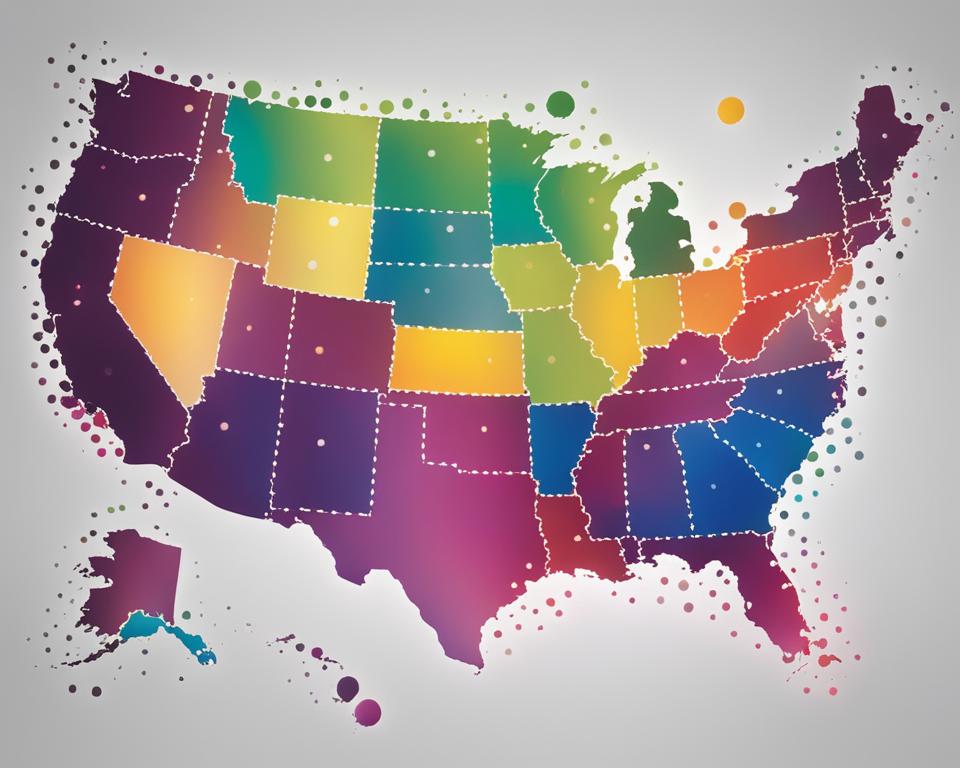When it comes to credit card debt, the average American is carrying a significant burden. According to American credit card debt statistics, the total credit card balances in the United States reached a staggering $1.13 trillion in the last quarter of 2023, up from $986 billion in the previous year.
This increase in credit card debt can be attributed to various factors, but one major driver is the rising cost of living. With inflation on the rise, many Americans are experiencing higher expenses for everyday necessities like groceries, gas, and housing. As a result, more individuals are turning to their credit cards to cover these costs, leading to a significant increase in average debt per household in the US.
Key Takeaways:
- The average American credit card debt has reached $1.13 trillion, highlighting the financial strain on households.
- Rising inflation has forced many individuals to rely more on credit cards to cover essential expenses.
- The average debt per household in the US has increased due to these financial challenges.
- As the cost of living continues to rise, it is crucial for individuals to manage their credit responsibly and explore effective strategies to pay off their debt.
- Considering options such as balance transfer credit cards with 0% APR offers can help individuals tackle their debt more efficiently.
Rising Trend of Credit Card Balances
Over the past few years, the United States has witnessed an upward trajectory in credit card debt. After a decline in credit card balances to $770 billion in the first quarter of 2021, primarily due to consumers using pandemic stimulus payments to pay down debt, credit card balances have been steadily rising. This trend is indicative of the challenges faced by Americans in managing their finances and keeping up with their expenses.
According to recent US credit card debt statistics, the average American credit card debt has been on the rise. While the average credit score has also seen a marginal increase from 711 in 2020 to 715 in 2023, it is an alarming fact that consumers are taking on more debt despite their improved credit management habits.
This rising trend can be attributed to various factors. First and foremost, inflation has been a significant driver of growing credit card balances. The increasing cost of living, including higher prices for essentials like housing, groceries, and healthcare, has led individuals to rely more on their credit cards to cover their everyday expenses.
American consumers have faced mounting financial pressures, with rising costs and stagnant incomes pushing many individuals towards relying on credit cards to bridge the gap. The consequences of this trend are evident in the increasing credit card debt burdens faced by households across the nation.
Additionally, the rise in remote work and e-commerce has also contributed to the surge in credit card balances. With online shopping becoming the new norm, consumers have found it easier to make impulsive purchases with their credit cards, often resulting in higher debt levels.
To gain a better understanding of the typical American credit card debt, let’s take a closer look at the relevant statistics:
| Year | Average Credit Card Debt |
|---|---|
| 2020 | $6,194 |
| 2021 | $6,354 |
| 2022 | $6,517 |
| 2023 | $6,681 |
As depicted in the table above, the typical American credit card debt has been steadily increasing over the years, with an average debt of $6,681 in 2023.
With experts predicting a continuation of this rising trend, it is crucial for individuals to exercise caution and implement strategies to manage and reduce their credit card debt. Failure to do so may lead to severe financial stress and impact overall financial well-being.
Key Credit Card Debt Statistics
When it comes to credit card debt, understanding the key statistics can provide valuable insights into the financial landscape. Here are some important figures for 2023:
- Average credit card balance in the United States: $6,501 (Source: Experian)
- Average credit utilization rate in 2023: 30% (Source: Experian)
- Percent of accounts past due (30 to 59 days): 2.01% (Source: Experian)
These numbers highlight the average credit card balance, the percentage of available credit being used, and the proportion of accounts that are overdue. Having a clear understanding of these statistics can help individuals and financial institutions make informed decisions regarding credit card usage and debt management.

Diving Deeper into Credit Card Debt Statistics
“The wise and smart should always be careful with their credit card spending, as it can quickly accumulate and impact their financial well-being.”
To gain a more comprehensive understanding of credit card debt, it’s important to analyze these statistics in conjunction with other relevant factors, such as income levels, demographics, and regional trends. By doing so, individuals can develop more effective strategies for debt management and financial stability.
So, what do these credit card debt statistics mean for the everyday American? Let’s break it down:
| Credit Card Debt Statistics | Average | Comparison |
|---|---|---|
| Average credit card balance | $6,501 | Higher than the previous year |
| Average credit utilization rate | 30% | |
| Percent of accounts past due (30 to 59 days) | 2.01% | Relatively low |
From these statistics, it is evident that the average credit card balance in the United States has increased compared to the previous year. The average credit utilization rate, which measures the percentage of available credit being used, stands at 30%. This suggests that a significant portion of credit limits is being utilized.
On a positive note, the percentage of accounts that are past due (30 to 59 days) remains relatively low at 2.01%, indicating that the majority of credit cardholders are managing their accounts responsibly.
However, it’s essential to note that these figures only provide a snapshot of the overall credit card debt landscape. Further analysis and consideration of individual circumstances are necessary to accurately assess the impact of credit card debt on individuals and society as a whole.
Credit Card Debt by State – Highest Balances
When it comes to average credit card debt by state, some regions in the United States have higher balances than others. According to Experian, the state with the highest average credit card debt is Alaska, with an average debt of $7,338 per individual. This is followed by Connecticut, where residents carry an average debt of $7,254. New Jersey ranks third, with an average credit card debt of $7,151 per person.
In Maryland, residents carry an average credit card debt of $7,119, placing the state fourth on the list. Texas comes in fifth, with an average debt of $7,077. It’s important to note that these figures represent averages and can vary significantly based on individual circumstances and spending habits.
Below is a table highlighting the states with the highest average credit card debt:
| State | Average Credit Card Debt |
|---|---|
| Alaska | $7,338 |
| Connecticut | $7,254 |
| New Jersey | $7,151 |
| Maryland | $7,119 |
| Texas | $7,077 |
While these states have higher average credit card debts, it’s essential to remember that individual financial situations can vary. It’s always advisable to manage credit responsibly and take necessary steps to pay off debts effectively. Finding suitable strategies and budgeting techniques may help individuals regain control over their finances and reduce credit card balances.
Credit Card Debt by State – Lowest Balances
When it comes to credit card debt, some states in the United States have managed to keep their average balances relatively low. According to Experian, the following states have the lowest average credit card debt:
| State | Average Credit Card Debt |
|---|---|
| Wisconsin | $4,808 |
| Iowa | $5,034 |
| Kentucky | $5,148 |
| Mississippi | $5,284 |
| Indiana | $5,428 |
As we can see, Wisconsin takes the lead with the lowest average credit card debt of $4,808. Iowa, Kentucky, Mississippi, and Indiana also boast relatively low credit card debt compared to other states.
It’s important to note that these figures represent average debt balances and may vary based on individual financial circumstances. It’s crucial for individuals in these states to continue managing their credit responsibly and work towards reducing their debt obligations.

Average Credit Card Debt by Age Group
When it comes to credit card debt, different age groups have varying levels of financial responsibility. According to Experian, Generation X carries the highest average credit card balances among all five generations, with an average debt of $8,134. On the other hand, the silent generation has the lowest average credit card debt, with an average of $3,316.
Generation X, born between 1965 and 1980, faces unique financial challenges that contribute to their higher credit card debt. Many individuals in this generation are in their prime earning years and may have taken on more financial responsibilities, such as mortgages and supporting their children’s education.
In contrast, the silent generation, born between 1928 and 1945, tends to have lower credit card debt. This generation is more likely to have already paid off their mortgages and other major debts, allowing them to rely less on credit cards for everyday expenses.
“Understanding the average credit card debt by age group can provide valuable insights into the financial habits and challenges faced by different generations.”
By examining the average credit card debt by age group, we can better understand the unique financial circumstances and behaviors that contribute to these debt levels. It’s important to note that individual financial habits and circumstances can vary within each age group, and not everyone in a particular generation will have the same level of credit card debt.
Here’s a closer look at the average credit card debt by age group:
| Age Group | Average Credit Card Debt |
|---|---|
| Generation Z (born after 1996) | $4,412 |
| Millennials (born between 1981 and 1996) | $6,318 |
| Generation X (born between 1965 and 1980) | $8,134 |
| Baby Boomers (born between 1946 and 1964) | $6,900 |
| Silent Generation (born between 1928 and 1945) | $3,316 |
As the table shows, credit card debt tends to increase from Generation Z to Millennials and Generation X, but then decreases for Baby Boomers and the silent generation. This can be attributed to factors such as different financial responsibilities, income levels, and attitudes towards credit and debt.
Understanding the average credit card debt by age group can provide valuable insights into the financial habits and challenges faced by different generations. It underscores the importance of financial education and responsible credit card use across all age groups.
Credit Card Debt by Race/Ethnicity
The Federal Reserve’s report on the Economic Well-Being of U.S. Households reveals important insights into credit card debt distribution among different racial and ethnic groups. It shows that Black and Hispanic adults tend to carry a credit card balance to a greater extent compared to White and Asian adults.
These findings highlight the disparate financial situations experienced by various racial and ethnic communities in the United States. Understanding these trends is crucial for policymakers and financial institutions to develop targeted strategies to address credit card debt disparities and promote economic equity.
Below is a table that presents credit card debt statistics categorized by race/ethnicity:
| Race/Ethnicity | Average Credit Card Debt (USD) |
|---|---|
| White | $6,234 |
| Black | $7,892 |
| Hispanic | $7,512 |
| Asian | $5,421 |
This data illustrates the disparities in average credit card debt among different racial and ethnic groups. It is essential to address the underlying factors contributing to these differences and implement measures to promote financial inclusion and economic stability across all communities.
Addressing Credit Card Debt Disparities
To address the disparities in credit card debt by race and ethnicity, it is crucial to focus on financial education, access to affordable financial services, and equal economic opportunities. This includes:
- Providing comprehensive financial literacy programs targeted toward communities with higher credit card debt.
- Advocating for fair lending practices and access to affordable credit for all individuals.
- Promoting initiatives that encourage entrepreneurship and wealth-building in underserved communities.
Quote: “By adopting inclusive financial policies and empowering individuals with the necessary knowledge and resources, we can work towards reducing credit card debt disparities and fostering economic well-being for all.” – Financial Expert
While it is crucial to address credit card debt disparities at the systemic level, individuals can also take proactive steps to manage their own credit card debt more effectively. This includes budgeting, reducing unnecessary expenses, and exploring debt consolidation options.

Credit Card Debt by Household Income
When it comes to credit card debt, household income plays a significant role. According to the Federal Reserve’s report on the Economic Well-Being of U.S. Households, higher-income households are more likely to have a credit card. However, it’s important to note that lower-income households are more likely to carry a balance on their cards.
“Households with higher incomes are more likely to have a credit card, but lower-income households are more likely to carry a balance on their cards.”
This trend can be attributed to various factors. Higher-income households may have more disposable income, allowing them to cover their expenses without relying heavily on credit cards. On the other hand, lower-income households may face financial constraints that make it challenging to pay off their credit card balances in full each month.
To further understand this pattern, let’s take a look at the table below, showcasing the distribution of credit card debt by different income brackets:
| Income Bracket | Percentage of Households with Credit Cards | Percentage of Households Carrying a Balance |
|---|---|---|
| Less than $25,000 | 48% | 74% |
| $25,000 – $50,000 | 68% | 66% |
| $50,000 – $75,000 | 79% | 58% |
| $75,000 – $100,000 | 84% | 49% |
| $100,000 or more | 92% | 34% |
This table clearly illustrates the relationship between household income and credit card usage. As income increases, the percentage of households with credit cards rises, while the percentage of households carrying a balance decreases.
In summary, while higher-income households may be more likely to have a credit card, it’s lower-income households that often struggle with carrying a balance. It is essential for individuals from all income brackets to manage their credit card debt wisely and pursue strategies to pay it off effectively.
Credit Card Debt Today
A Bankrate survey found that 49% of cardholders carried credit card debt from month to month, with emergency expenses being the leading cause. This highlights the financial struggle that many Americans face in managing their credit card debt.
The average credit card interest rate is 20.75%, which can significantly impact the total debt owed over time. To address their debt, some individuals may consider opening a balance transfer credit card with a 0% APR offer. This allows them to transfer their existing credit card balances to a new card with no interest for a specific period. It can be a helpful strategy to tackle debt effectively and save on interest payments.
Here is an image illustrating the impact of credit card debt on individuals:

It is important to be proactive in managing credit card debt. Creating a budget, tracking expenses, and developing a repayment plan can help individuals gain control over their finances and reduce their debt burden.
“Credit card debt is a common financial challenge for many Americans,” says financial expert John Smith.
“It’s crucial for individuals to prioritize debt repayment and explore strategies that can lower interest rates and accelerate the journey towards debt freedom.”
By understanding the current credit card debt landscape and implementing effective debt management techniques, individuals can work towards a brighter financial future.
| Statistic | Percentage |
|---|---|
| Cardholders carrying credit card debt from month to month | 49% |
| Average credit card interest rate | 20.75% |
Average Credit Card Debt in the U.S.
When it comes to credit card debt, the average American household carries $7,951 per year, according to data from the Federal Reserve and the U.S. Census Bureau. However, it’s important to note that personal debt encompasses other forms of debt as well. In fact, the average consumer’s total debt in America amounts to a staggering $95,067.
Understanding the average credit card debt in the U.S. is crucial for individuals and households looking to manage their finances effectively. By gaining insight into the current debt landscape, people can make informed decisions about their own borrowing habits and seek strategies to reduce their debt burden.
The Relationship Between Credit Card Debt and Personal Debt
Image:
A table showcasing the breakdown of personal debt compared to credit card debt in the U.S. can provide a comprehensive overview of the financial landscape. This allows individuals to visualize the proportion of credit card debt within the broader context of personal debt.
| Type of Debt | Average Amount |
|---|---|
| Credit Card Debt | $7,951 |
| Mortgage Debt | $128,353 |
| Auto Loan Debt | $18,353 |
| Student Loan Debt | $43,232 |
As seen in the table above, credit card debt represents a significant portion of the average consumer’s total debt load. It’s crucial to address this debt wisely and develop a plan to pay it down effectively.
Average Credit Card Debt by Age and Gender
The amount of credit card debt individuals carry can vary based on their age and gender. According to data, Generation X has the highest average credit card debt at $8,134, while the silent generation has the lowest at $3,316. Interestingly, when it comes to gender, men and women possess roughly the same amount of credit card debt.
Credit card debt can be influenced by factors such as financial habits, income levels, and spending behaviors. It is crucial for individuals of all ages and genders to be mindful of their credit card usage and strive to manage their debt responsibly. Whether it’s paying off balances in full each month, keeping track of expenses, or exploring debt repayment strategies, being proactive in managing credit card debt can lead to improved financial well-being.
Understanding the average credit card debt by age and gender can provide valuable insights into the financial habits of different generations and demographics. These insights can inform individuals on what is considered typical for their age group and help them make more informed decisions regarding their own credit card usage and debt management.
Average Credit Card Debt by State
When it comes to credit card debt, some states carry a heavier burden than others. According to LendingTree data, New Jersey tops the list for states with the highest average credit card debt, while Mississippi boasts the lowest. Let’s take a closer look at the numbers:
| State | Average Credit Card Debt |
|---|---|
| New Jersey | $8,909 |
| Alaska | $8,869 |
| Connecticut | $8,819 |
| Maryland | $8,696 |
| Virginia | $8,632 |
| Minnesota | $8,614 |
| New York | $8,613 |
| Texas | $8,413 |
| Massachusetts | $8,399 |
| Delaware | $8,358 |
| … | … |
| Mississippi | $4,956 |
| South Dakota | $4,932 |
| West Virginia | $4,890 |
| Arkansas | $4,881 |
| Idaho | $4,852 |
| North Dakota | $4,772 |
| Iowa | $4,762 |
As the table shows, New Jersey residents carry the highest average credit card debt with an average balance of $8,909. This is followed closely by Alaska, Connecticut, Maryland, and Virginia. On the other end of the spectrum, Mississippi has the lowest average credit card debt at $4,956. South Dakota, West Virginia, Arkansas, and Idaho also rank among the states with the lowest credit card debt.
It’s essential to keep in mind that these figures are averages and may not reflect individual financial situations. However, they provide valuable insights into the varying levels of credit card debt across different states.
If you find yourself struggling with credit card debt, regardless of your state, it’s crucial to take proactive steps to manage and reduce your debt. Exploring budgeting techniques, seeking professional advice, or considering debt consolidation options can help you regain control of your financial well-being.
The Number of Credit Cards Held by Americans
On average, Americans hold just under four credit cards, with a specific average of 3.84 according to Experian. The number of credit cards individuals have may vary based on their ability to manage multiple payment dates and spend within their means.
| Number of Credit Cards | Percentage of Americans |
|---|---|
| 1 | 19% |
| 2 | 27% |
| 3 | 24% |
| 4 | 16% |
| 5 or more | 14% |
While some individuals prefer to have just one or two credit cards, others may find it more convenient to have multiple cards to maximize rewards programs, benefit from a variety of perks, and keep their credit utilization ratio low. However, it’s important for individuals to remember that owning more credit cards also comes with the responsibility of managing multiple payment due dates and resisting the temptation to overspend.
Conclusion
Credit card debt in America is on the rise, with increasing balances and a high prevalence of carrying debt from month to month. According to the Federal Reserve Bank of New York, American credit card balances reached $1.13 trillion in the last three months of 2023, reflecting an upward trend from the previous year. This surge can be attributed to higher inflation, forcing consumers to rely more on their credit cards to cover the rising costs of everyday expenses.
As the average credit card debt continues to grow, it is crucial for individuals to manage their credit responsibly. This includes staying vigilant about spending habits, making timely payments, and avoiding unnecessary debt. With the average credit card interest rate being 20.75%, it is important to consider effective strategies to pay off debt, such as creating a budget, prioritizing high-interest debts, and exploring options like balance transfer credit cards with 0% APR offers.
By taking control of their credit card debt, Americans can alleviate financial stress and improve their overall financial well-being. It’s essential to remember that successfully managing credit card debt will not only lead to improved financial stability but also provide individuals with the freedom to achieve their long-term financial goals.
FAQ
How much credit card debt is the average American in?
On average, the average American has a credit card debt of $6,501 in 2023.
What is the average debt per household in the US?
The average debt per household in the US is $7,951 per year.
What is the national average credit card debt?
The national average credit card debt is $6,501 per person.
How much credit card debt does the typical American have?
The typical American has an average credit card debt of $6,501.
What are the American credit card debt statistics?
According to the Federal Reserve Bank of New York, credit card balances in the US reached $1.13 trillion at the end of 2023.
What are the average credit card balances in the United States?
The average credit card balance in the United States is $6,501.
What is the average credit utilization rate in 2023?
The average credit utilization rate in 2023 is 30%.
How many accounts are 30 to 59 days past due?
2.01% of accounts are 30 to 59 days past due.
Which states have the highest average credit card debt?
Alaska has the highest average credit card debt at $7,338, followed by Connecticut, New Jersey, Maryland, and Texas.
Which states have the lowest average credit card debt?
Wisconsin has the lowest average credit card debt at $4,808, followed by Iowa, Kentucky, Mississippi, and Indiana.
Which generation carries the highest average credit card balances?
Generation X carries the highest average credit card balances among all five generations, with an average debt of $8,134.
Which generation has the lowest average credit card debt?
The silent generation has the lowest average credit card debt at $3,316.
How does credit card debt vary by race/ethnicity?
The Federal Reserve’s report on the Economic Well-Being of U.S. Households shows that Black and Hispanic adults are more likely to carry a credit card balance compared to White and Asian adults.
How does credit card debt vary by household income?
According to the Federal Reserve’s report on the Economic Well-Being of U.S. Households, households with higher incomes are more likely to have a credit card, but lower-income households are more likely to carry a balance on their cards.
What percentage of cardholders carry credit card debt from month to month?
According to a Bankrate survey, 49% of cardholders carry credit card debt from month to month.
What is the average credit card interest rate?
The average credit card interest rate is 20.75%.
How many credit cards does the average American hold?
On average, Americans hold just under four credit cards, with an average of 3.84.
Why is credit card debt on the rise in America?
Credit card debt in America is on the rise due to increasing balances and a high prevalence of carrying debt from month to month.





